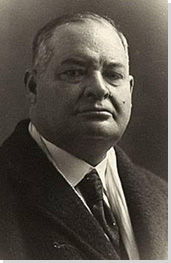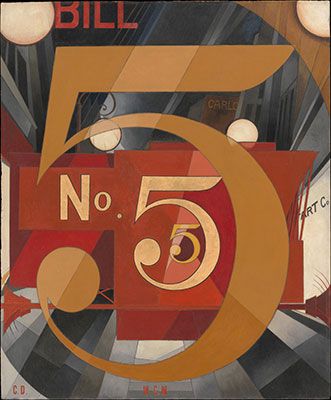Summary of Joseph Stella
Joseph Stella's professional career left a lasting mark on American modernism, but it was just as fraught and unsteady as his personal life. Following the hugely influential 1913 Armory Show, he became a key figure in the New York art world. His style and subject matter changed frequently throughout his career, reflecting his own search for meaning and identity as an immigrant working in a rapidly changing urban America. Perhaps because of his outsider status, his images of industrial America were his most successful and influential. Indeed, his images of New York City landmarks such as the Brooklyn Bridge are depicted with the power and honesty only truly possible from a truly dynamic mind.
Accomplishments
- Although famous for his depictions of American scenes, Stella was never fully at home in his adopted country. Indeed, he spent long spells travelling and working in Europe, only returning to New York when necessary.
- Stella was largely responsible for bringing Futurism to the United States, and was a leading figure in the burgeoning Precisionist movement of the 1920s and 1930s. While the subjects and even the style of his work varied, he maintained a Precisionist interest in distinct areas of line and color throughout the duration of his career.
- In spite of his very modernist interests, the influence of historical European art movements is ever-present in Stella's work, from the stained glass quality of his paintings, to the references to Renaissance and Gothic architecture and altarpieces. His Italian artistic heritage informed his works throughout the course of his career.
Important Art by Joseph Stella
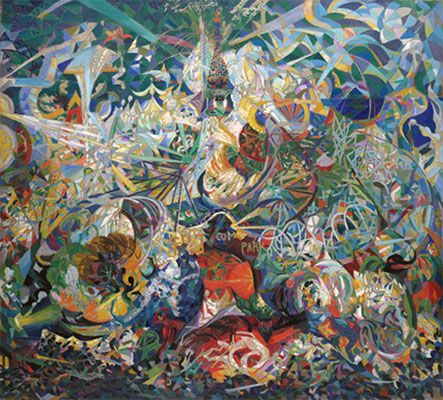
Battle of Lights, Coney Island, Mardi Gras
Stella began this abstract rendition of the sights and sounds of Coney Island in late 1912, after returning to the United States from Paris. It was his first work in the Futurist mode, and is an excellent example of the ways in which he utilized the techniques and ideas of European modernism to capture this quintessentially American scene, depicting New York's iconic roller coaster at Coney Island. Stella was captivated by the amusement park, describing it as an "intense arabesque" with its "surging crowd and the revolving machines generating... violent, dangerous pleasures." Forms are fractured and faceted to create a fragmented, kaleidoscopic vision of roller coasters, spinning rides, and colorful buildings, all disembodied by light and bright hues. Glimpses of signs allude to the real-life attractions of the day, such as Feltman's restaurant (where the hot dog was invented) and Steeplechase Park, which boasted a Ferris wheel, scale models of world landmarks, and a mechanical horse racing game. When this painting was exhibited in New York City, the popular reception was negative, even though art critics admired it. After a few years, however, it was accepted as a hugely influential work of the American avant-garde.
Oil on Canvas - Yale University Art Gallery
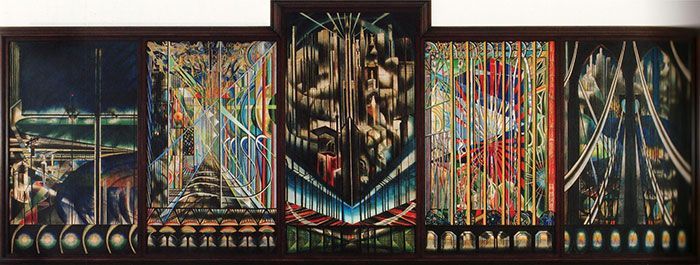
Voice of the City of New York Interpreted
Many critics and curators of Stella's work consider this monumental, five-panel painting to be his finest work. It was something of a paean to the technological and cultural innovations that made New York one of the most vibrant modern cities in the world during the 1920s. All over the world, New York City and its celebrated skyscrapers remained an object of fascination.
The bold, brightly colored panels, each measuring over seven feet tall, depict distinct areas of the city. The first panel on the left depicts the port; the second depicts the dazzling electric lights of Broadway and Times Square; the central panel depicts Manhattan's towering skyscrapers, with the iconic Flatiron building front and center; Broadway, or the "White Way" is the focus of the fourth panel, which also integrates images of subway tunnels at the bottom; and the far right panel offers a romanticized view of the Brooklyn Bridge.
There is a musical quality to Stella's treatment of Broadway in the second and forth panels. The vibrant colors evoke neon signs, and crossing beams of light resemble the spotlights of a theatrical production. The use of bold, parallel lines throughout the piece draws the eye ever upward, much in the manner of the ever-expanding Manhattan skyline. The geometric planes and graphic, architectural lines of the composition reflect the influence of Italian Futurism on Stella's work, while the use of rich color and the resemblance to colorful stained-glass windows anticipate his later fascination with Renaissance-like styles and subjects.
Oil and Tempera on Canvas - Newark Museum
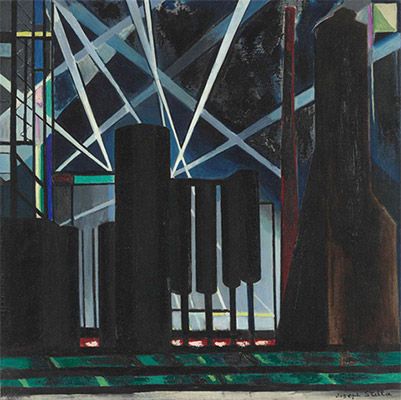
By-Products Plants
In this painting, Stella depicts factories that extract ammonia, tar, and light oils that are released when coal is burned. Such mechanical processes fascinated Stella, and he once recalled, "Opposite my studio was a huge factory . . . towering with the gloom of a prison. At night fires gave to innumerable windows menacing blazing looks of demons." Imposing, shadowy buildings, tanks, and chimneys are interspersed with radiant, intersecting beams of light, a contrast that gives the painting an eerie, mysterious quality that hints at the complex chemical processes occurring within the factories. There is a captivating hint of danger that is intriguing but also oddly beautiful. The shining spotlights give a sense of expectation of something wondrous occurring - such as the announcement of new product release or a movie presentation.
The painting is a representative example of the Precisionist movement, which celebrated the industrial, modern landscape of the United States through geometric, Cubist-inspired depictions of factories, bridges, and skyscrapers. Before the early-20th century such industrial and utilitarian structures were not typical subjects for artists, but, with the help of artists like Stella, industrial architecture became a powerful symbol of the distinct textures of American life for many artists. At the same time, the composition's bold, bright colors, sense of movement, and contrast between light and shadow reveal Stella's debt to the Futurists.
Oil on Canvas - The Art Institute of Chicago
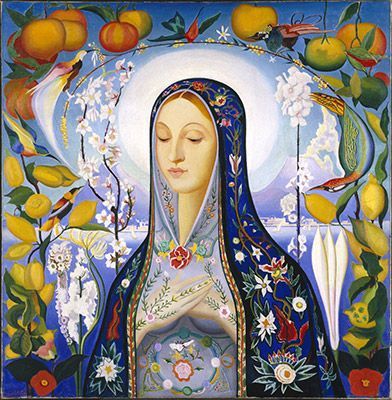
The Virgin
Stella spent the bulk of his time in Europe during the late 1920s and early 1930s, returning to the United States only when exhibitions required it. Though the American art scene, especially New York's architecture, had long been a source of fascination for him, the traditions of his native Italy continued to draw his attention and influence his art. The 1920s in Italy saw a renewed appreciation for early Renaissance art, particularly artists such as Piero della Francesco and Giotto. One of the leading voices of this Renaissance revival was actually Carlo Carra, the Futurist whose work had helped to inspire much of Stella's early painting.
With The Virgin, Stella moved dramatically away from the industrial and urban scenes that made him famous, turning instead to a highly traditional subject: the biblical figure of the Virgin Mary. Stella has given her a youthful appearance, with a placid and gentle face. He surrounds her with bright and colorful flowers and fruit, symbols of beauty and fertility, and places her in front of the Bay of Naples, as if in homage to his native land. The highly saturated colors and symmetry of the composition lends the work a distinct personality that is at once medieval and modern. In a letter to Carra, Stella expressed his hope that New York would get the chance to experience "the brave new conquests made by you and your companions to the Glory of Italy." This new interest in a representational style and traditional subject matter hints at America's ties to European cultural heritage. Moreover, Stella's interest in exploring overtly religious subject matter marks the culmination of a long career, throughout which religion always lay just beneath the surface.
Oil on Canvas - Brooklyn Museum
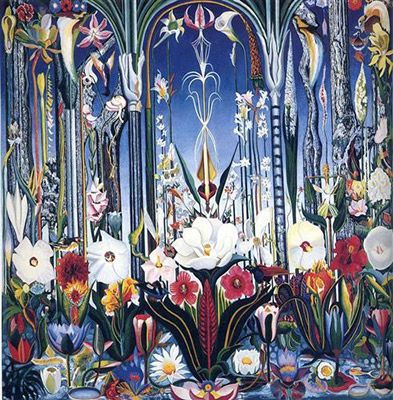
Flowers, Italy
At first glance, this colorful painting, depicting an enormous variety of vibrant flowers in full bloom, seems to have little in common with the inorganic, structural forms of Stella's iconic New York canvases. But close inspection reveals that it is an architectural arrangement of organic forms. The vegetal and floral forms resemble supporting piers, pillars, cables, and arches, in a construction that strongly resembles Stella's earlier studies of the Brooklyn Bridge. At the same time, the painting shows the influence of Italian art on his work, in its references to both to stained glass (in the geometric areas of distinct color) and to the architectural frames of early Renaissance paintings (in the three arches running along the top). Although the painting seems to be rigidly symmetrical, there are slight irregularities; for instance, a red dahlia on the lower left is mirrored by a different flower - a red plumeria - on the lower right. The general effect suggests symmetry, but nothing on one side exactly mirrors what is on the other side.
The painting reveals the ways in which Stella combined past and present sources of inspiration in his later art, uniting Precisionist, geometric lines with still-life renderings of natural objects. It is also representative of a broader renewal of interest in traditional subject matter in modernist art during the 1920s and 1930s, when the First World War had caused many artists and writers to question the human cost of technological "progress" and innovation.
Oil on Canvas - Phoenix Art Museum
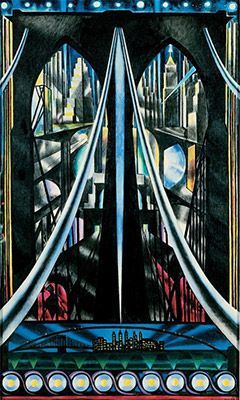
The Brooklyn Bridge: Variation on an Old Theme
Stella first painted the Brooklyn Bridge in 1918 and returned to it repeatedly throughout his career. This piece, painted toward the end of his life, blends the Futurist and Cubist sensibilities of his early work with the religious undertones and saturated color that typify the paintings he produced in Europe during the late 1920s and early 1930s. The painting depicts the bridge as something of a modern-day altar; it is a place of spiritual significance. He uses crisp, angular lines to impart both dynamism and monumental solidity to the structure. The bridge's cables invoke the soaring pointed arches of Gothic architecture, and they are underscored by a rich, jewel-toned color palette that recalls the intricate stained glass of Gothic cathedral windows. The visual allusion to religious architecture gives the bridge itself a weighty, other-worldly significance. These sharply curving cables also impart a sense of energy and movement to the composition, drawing the viewer's gaze up and toward the center from both the left and right corners of the canvas. By offering a bold, bright new twist on a favorite subject, this painting perfectly illustrates the ways in which Stella's style had evolved into something more personal and idiosyncratic by the later years of his life.
Oil on Canvas - Whitney Museum of American Art
Biography of Joseph Stella
Childhood
Stella grew up in the small mountain village of Muro Lucano, situated over a ravine in the Potenza province of southern Italy, near Naples. The fourth of five brothers, he was a pudgy, solitary, and contemplative child, with few friends his own age. His father and grandfather were attorneys, and their family was prosperous, though Stella showed little interest in pursuing the family vocation. From a young age, he showed a precocious talent for drawing and developed a passionate interest in art. He was also a strong student in school, where he learned both English and French.
When he was nineteen years old, he moved to New York City to study medicine and pharmacology. Upon arriving at Ellis Island, Stella adopted the Americanized version of his name. Thus, Giuseppe Michele Stella became Joseph Stella. His family would continue to call him by his childhood nickname, "Beppino," for years.
Early Training
After studying in New York for two years, Stella abandoned his plans to become a doctor. While studying medicine, he had taken a course on antiques at the Art Students League, which inspired him to transfer to the New York School of Art. There, he studied under William Merritt Chase, the American impressionist painter who would later found the Chase School (now the Parsons School of Design). Another of Stella's teachers was the leading Ashcan School painter Robert Henri, who asserted that no subject was too mundane for art. He inspired Stella to turn to the city's immigrant population for inspiration, and to become an advocate for the just treatment of his fellow immigrants. In 1902, Stella married Mary French. Their marriage was fraught: they lived apart for extended periods of time and Stella had several mistresses over the years.
After completing his studies, Stella worked as a magazine illustrator from 1905 to 1909, focusing mainly on realist drawing. During this time, he made several drawings of immigrants and miners for the magazines Outlook and Survey. He was also developing his skills as a painter, and his painting The Old Man earned praise at a 1906 exhibition at the Society of American Artists in New York.
In 1909, Stella returned to Europe, spending a year in his native Italy, visiting Rome, Florence, Naples, and his hometown of Muro Lucano. He then traveled to Paris, where he met a number of Italian Futurist artists, including Gino Severini, Carlo Carra, and Umberto Boccioni. He also became acquainted with the painters Matisse and Picasso, as well as the influential American writer Gertrude Stein. Stella later spoke of Stein as an aloof, pretentious figure, "enthroned on a sofa in the middle of the room." His trip to Europe left a lasting imprint on him as the Futurist and Cubist commitment to modern life - as opposed to nostalgia for the past - resonated deeply.
In 1912, he returned to New York, where he began his first major work in the Futurist vein, Battle of Lights, Mardi Gras, Coney Island (1913). He also participated in New York's watershed Armory Show of 1913, the first major exhibition of modern art in America, which introduced him to Marcel Duchamp, Albert Gleizes, Alfred Stieglitz, and the prominent modern art collector Walter Arensberg. He became friends with Stieglitz and later with his wife, Georgia O'Keeffe. Stella became firmly entrenched in the avant-garde of early-20th-century New York. He was even associated with Duchamp's seminal Fountain (1917), the spark of inspiration for which reportedly came from a conversation with Stella and Arensberg. Stella is said to have accompanied Duchamp to the plumbing supply store to purchase the urinal used in the infamous sculpture. Arensberg regularly hosted salons with prominent New York artists, which the wife of the painter Francis Picabia once described "as an inconceivable orgy of sexuality, jazz, and alcohol."
Mature Period
Stella's Futurist work continued to attract comment and attention from influential members of the New York art world. By the 1920s he had become fascinated with the geometric architectural qualities of Lower Manhattan, and the city's urban landscape became the subject of some of his best-known works, which blended elements of Futurism and Cubism. His renderings of the Brooklyn Bridge from this time were a great success and likely inspired (at least partially) Hart Crane's epic modernist poem, The Bridge (1930).
During the twenties Stella also produced a number of collages, drawing on the work of German artist Kurt Schwitters, as well as the anti-establishment Dada movement. His collages consisted of paper scraps, wrappers (some with visible branding or logos), and other bits of ephemera of city life, often interspersed with bold strokes of paint. These collages were never exhibited during his lifetime, and were seen only by his intimate circle of friends and family.
Stella became an American citizen in 1923, but was unable to shake his lingering feelings of homesickness and displacement. He made numerous trips abroad, splitting his time between Paris and Italy from 1926 and 1934, and returned to New York periodically to help coordinate exhibitions of his work. During this time, he began to move away from the modernist aesthetic, looking instead to nature and religion as new sources of inspiration. He traveled to the Caribbean and North Africa, where he focused on capturing their pristine natural environments in his colorful still lifes and bold landscapes. His approach to painting varied a great deal during these years. In some instances, he took advantage of the possibilities of realism; in others he utilized the expressive power of abstraction; and in still others he delved into the complex worlds of surrealism.
Late Period
Stella moved back to New York permanently in 1934, settling in the Bronx with his wife Mary. By this time, his popularity in the United States had begun to fade, and his difficult personality had alienated a number of formerly close friends. He was employed by the Works Project Administration, which provided government funding for the arts. Although he was largely unsympathetic to the populist ethos of the organization, he worked for the WPA until 1937.
In 1938 he traveled to Barbados for the first time with Mary, who was seriously ill. There he was hugely impressed with what he later called "the magic island," which inspired much of his late works. He painted tropical plants and exotic flowers in a manner reminiscent of Gauguin's Tahitian landscapes and portraits. He later commented that his creativity was renewed by the new environment: "My drowsing energy, tortured by the cold of northern countries, was reawakened as if by magic, set aglow by the radiance of gold and purple light. All the ardor of youth surged through me, with the overflowing, stinging, demanding desire for new conquests in the virgin lands of art." Sadly, Mary succumbed to her illness during their visit. Later, Stella again traveled to Europe and Africa, before returning to New York for a retrospective of his work at the Newark Museum in 1939. Unfortunately, the exhibition was not the success he had hoped for, and it failed to renew interest in his work.
He was diagnosed with heart disease in the early 1940s, and became increasingly fretful and anxious about his health. He was often confined to his bed after 1942, and suffered ongoing medical upsets: a surgery for a blood clot in his left eye proved unsuccessful, and he was also seriously injured when he fell down an open elevator shaft. He moved a number of times during the early 1940s, first staying in Little Italy, and then Greenwich Village near friends. He was finally forced to move to Queens, where family members could look after him. He died of heart failure in 1946, and is interred in the Bronx's historic Woodlawn Cemetery.
The Legacy of Joseph Stella
Stella's depictions of New York's cityscapes and industrial architecture led him to become a major figure in the Precisionist movement. This was the first indigenous modern art movement in America, and included artists such as Charles Demuth, Charles Sheeler, Gerald Murphy, Elsie Driggs, and Niles Spencer. Like Stella, these artists chose subjects that were unique to 20th-century life, including skyscrapers, suspension bridges, and factory complexes.
His earlier, more abstract pieces such as Battle of Lights, Coney Island, Mardi Gras (1913-14) can be said to have anticipated Abstract Expressionism and the Action Paintings of Jackson Pollock. Stella's dynamic, ever-changing style also had a tremendous impact on later artists, including the Color Field paintings of Helen Frankenthaler, the post-Cubist works of Edgar Ewing, and the Abstract Realist urban scenes of De Hirsh Margules, to name just a few.
Influences and Connections

Useful Resources on Joseph Stella
- Joseph Stella (Overview of 1994 Whitney retrospective)Our PickBy Barbara Haskell
- Joseph Stella's SymbolismOur PickBy Irma B. Jaffe
- Visual Poetry: The Drawings of Joseph StellaBy J. Mozer
- Joseph Stella: The TropicsBy Richard T. York
- Joseph Stella: The Hirshhorn Museum and Sculpture Garden CollectionBy Judith Zilczer
- Passion and Reverence: Joseph Stella and the Natural WorldBy Richard T. York and Kate Davis
 Ask The Art Story AI
Ask The Art Story AI